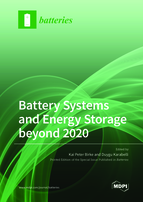Battery Systems and Energy Storage beyond 2020
A special issue of Batteries (ISSN 2313-0105).
Deadline for manuscript submissions: closed (31 July 2021) | Viewed by 96423
Special Issue Editors
Interests: battery cell research; battery system technology; battery block building kits; modeling of battery cells and battery systems; battery state estimation (state of charge, state of health, state of function); implementation of artificial intelligence for detrmination of battery cell parameters with enhanced accuracy; digital twins for battery cells and battery systems; high boiling point safety enhanced electrolytes; double layer capacitors; pseudo 3D-capacitors; power to X (X = gas, liquid, solid)
Special Issues, Collections and Topics in MDPI journals
Interests: Li-ion batteries; next generation Li-S and Li-air batteries; solid-state batteries; polymer electrolytes; battery production; industry 4.0
Special Issue Information
Dear Colleagues,
Nowadays, the transformation from the combustion engine to electrified vehicles is a matter of fact and tremendously drives the demand for compact, high energy-density rechargeable lithium ion batteries as well for large stationary batteries to buffer solar and wind energy. The future challenges, e.g., decarbonization of the CO2 intensive transportation sector, will push the need for such batteries even more.
The cost of lithium ion batteries has become competitive in the last few years, and lithium ion batteries are expected to dominate the battery market in the next decade. However, despite remarkable progress, there is still a strong need for improvements in lithium ion batteries’ performance. Further improvements are not only expected in the field of electrochemistry but can also be distinctly pushed by improved manufacturing methods, diagnostic algorithms, lifetime prediction methods, implementation of artificial intelligence, and digital twins. Therefore, this Special Issue addresses the progress in battery and energy storage development by pushing a missing focus on digitalization, advanced cell production, modeling, and prediction aspects in concordance with progresses in new materials and pack design solutions.
Potential topics include but are not limited to:
- Electrical, thermal, and electrochemical modeling;
- Lifetime estimation of battery cells;
- Accuracy enhancement methods for battery states and life time estimation;
- Implementation of artificial intelligence in battery diagnostics;
- Digital Twins for battery cells;
- Digital Twins for battery systems;
- Digital Twins in advanced battery productions;
- New materials and advanced manufacturing methods in battery cell production;
- Cell size optimization for advanced Li-ion batteries;
- Battery cell and pack design;
- Advanced electrolytes for Li-based batteries;
- Advances in battery cell manufacturing technologies;
- Life cycle assessment.
Prof. Dr.-Ing. Kai Peter Birke
Dr.-Ing. Duygu Kaus
Guest Editors
Manuscript Submission Information
Manuscripts should be submitted online at www.mdpi.com by registering and logging in to this website. Once you are registered, click here to go to the submission form. Manuscripts can be submitted until the deadline. All submissions that pass pre-check are peer-reviewed. Accepted papers will be published continuously in the journal (as soon as accepted) and will be listed together on the special issue website. Research articles, review articles as well as short communications are invited. For planned papers, a title and short abstract (about 100 words) can be sent to the Editorial Office for announcement on this website.
Submitted manuscripts should not have been published previously, nor be under consideration for publication elsewhere (except conference proceedings papers). All manuscripts are thoroughly refereed through a single-blind peer-review process. A guide for authors and other relevant information for submission of manuscripts is available on the Instructions for Authors page. Batteries is an international peer-reviewed open access monthly journal published by MDPI.
Please visit the Instructions for Authors page before submitting a manuscript. The Article Processing Charge (APC) for publication in this open access journal is 2700 CHF (Swiss Francs). Submitted papers should be well formatted and use good English. Authors may use MDPI's English editing service prior to publication or during author revisions.







